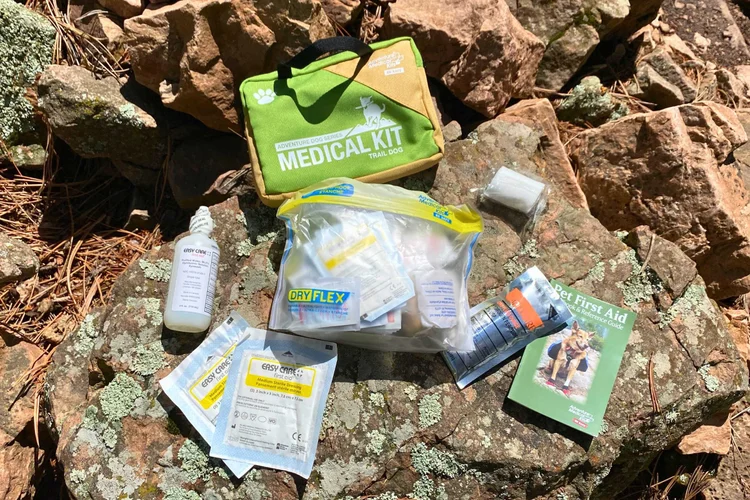Imagine your dog suddenly needs help, but you don’t have the right supplies on hand. Would you know what to do?
Building a dog first aid kit for home and travel is one of the smartest ways to keep your furry friend safe. With the right tools ready, you can act fast and with confidence during emergencies. In this guide, you’ll discover exactly what to include in your kit and how to prepare for any unexpected situation.
Keep reading to learn how to protect your dog wherever you go.
:strip_icc()/arca-0612464-arca-pet-first-aid-kit-for-cats-and-dogs-99aba5deab0148f3bca46d033ed108cb.jpg)
Credit: www.thesprucepets.com
Choosing The Right Container
Choose a container that fits your space and travel needs. Small kits are easy to carry on trips. Bigger ones hold more supplies for home use. Look for waterproof and durablematerials to protect contents from spills and weather. Hard cases protect items from damage, while soft bags are light and flexible.
Organizing compartments help keep things tidy. Separate sections for bandages, medicines, and tools save time in emergencies. Clear pockets let you see supplies quickly. Use elastic loops or mesh dividers to hold items in place. A well-organized kit means faster help for your dog.
Basic Medical Supplies
Bandages and dressingshelp stop bleeding and protect wounds. Keep different sizes for small and big cuts. Adhesive bandages are good for minor scrapes. Gauze pads work well for larger wounds. Wrap wounds gently but firmly with a bandage to keep dirt out.
Antiseptics and ointmentsclean wounds and stop infections. Use antiseptic wipes or solutions to clean cuts. Apply antibiotic ointment to help healing and prevent germs. Avoid using human medicines without advice from a vet.
Tweezers and scissorsare useful tools in a dog first aid kit. Tweezers remove thorns, splinters, or ticks safely. Scissors cut bandages and dressings to the right size. Choose scissors with blunt tips to avoid accidents.
Medications For Common Issues
Pain reliefis important for injured or sick dogs. Keep dog-safe painkillerslike aspirin or carprofen, but never give human medicinewithout vet advice. Anti-inflammatory drugshelp reduce swelling and ease discomfort.
Allergy and itch treatmentsinclude antihistamines like diphenhydramine. They help calm itching and allergic reactions. Use calming creamsor sprays for skin irritations. Always check the correct dose for your dog’s size.
Digestive aidshelp with upset stomachs or diarrhea. Keep activated charcoal for mild poisoning cases. Probiotics can support healthy digestion. Plain canned pumpkin also soothes upset tummies.
Tools For Emergency Care
Thermometerhelps check your dog’s temperature quickly. Use a digital one for easy reading. Gloveskeep you safe and clean during care. Always wear disposable gloves to avoid germs.
A muzzlestops biting when your dog is scared or hurt. Soft muzzles work best for comfort. Restraintshelp keep your dog still. Use a leash or towel to gently hold them.
For eye care, keep saline solution ready to wash dirt or chemicals out. Use cotton balls for gentle cleaning. For ear care, have ear cleaner made for dogs. Keep their ears dry and free from wax build-up.
Personal Items And Documentation
Keep your dog’s medical recordsand contact infohandy. This helps vets treat your pet fast. Include vaccination dates, allergies, and past illnesses. Add your vet’s phone number and your emergency contacts.
A leash and collarare must-haves. They keep your dog safe and under control. Choose a strong leash that suits your dog’s size. A collar with ID tags helps identify your dog if lost.
An emergency blanketkeeps your dog warm during shocks or cold weather. It is lightweight and easy to pack. This item is great for both home and travel kits.

Credit: www.treelinereview.com
Packing For Home Vs Travel
Building a dog first aid kit needs different items for homeand travel. At home, keep basic supplies like bandages, antiseptic wipes, and tweezers. For travel, pack lighter and add items for quick fixeson the go.
Tips for Air Travel:Use a small, easy-to-carrykit. Include your dog’s medical records, any needed medicine, and a leash. Make sure all liquids follow airline rules. Add a collapsible water bowl and some treats.
Car Travel Essentials:Bring a larger kit with more supplies. Include a blanket, extra water, and a muzzle for safety. Keep a copy of your vet’s contact info handy. Remember to pack a flashlight and waste bags too.
Maintaining And Updating The Kit
Check all items in the kit regularly. Expired medicineslose their power and can be unsafe. Mark the dates on a calendar or set a reminder on your phone. Replace any used or damaged supplies quickly. This keeps the kit ready for emergencies.
Adjust the kit for different seasons. Add tick removersin summer and warm blanketsin winter. Change bandages if they get wet or dirty. Keep the kit clean and organized.

Credit: www.treelinereview.com
Training And Preparedness
Basic first aid skillshelp owners act fast during dog emergencies. Learn how to clean wounds, stop bleeding, and treat burns. Practice checking your dog’s breathing and pulse. Know how to perform CPRif needed. Keep calm and move carefully to avoid more harm.
Seek veterinary helpif your dog shows signs like heavy bleeding, difficulty breathing, or unconsciousness. Sudden weakness, seizures, or swallowing poison need urgent care. Always trust your instincts. When unsure, call a vet immediately.
| Emergency Contact | Details |
|---|---|
| Local Vet Clinic | Phone number, address, and hours |
| Animal Poison Control | Emergency hotline for toxic substances |
| Nearby Animal Hospital | 24/7 emergency services |
| Trusted Friend or Family | Available to assist in emergencies |
Frequently Asked Questions
What Essentials Should Be In A Dog First Aid Kit?
A dog first aid kit must include bandages, antiseptic wipes, tweezers, scissors, and gauze. Also, add a digital thermometer, disposable gloves, and a pet-safe antiseptic. Including a muzzle can help safely handle an injured dog.
How Do I Store My Dog’s First Aid Kit?
Store your dog’s first aid kit in a waterproof, portable container. Keep it in an easily accessible spot at home and carry a compact version during travel. Regularly check and replace expired or used items.
Can I Use Human Medication For My Dog’s Injuries?
Avoid using human medication without vet approval. Some drugs safe for humans are toxic to dogs. Always consult your vet before administering any medicine to your pet.
How Often Should I Update My Dog’s First Aid Kit?
Update your dog’s first aid kit every six months. Check expiration dates and replace used or outdated supplies. Regular updates ensure your kit is ready for emergencies.
Conclusion
Building a dog first aid kit protects your pet at home and on trips. Keep it simple and include basic supplies for common emergencies. Check the kit often and replace used or expired items. Knowing how to use the kit helps you act fast during accidents.
A prepared owner feels calm and confident. Start today and give your dog the safety they deserve.





